Cherie Magnus's Blog, page 6
December 6, 2011
La Confiteria Ideal--the Soul of Tango
La Confitería Ideal
is the iconic tango salon of Buenos Aires. When tourists and dancers alike pass through the double doors on Suipacha near Corrientes, they feel in their gut they are entering the historic soul of tango.
However La Ideal spent almost all of its life since it was built in 1912 as a pastry shop and salon de te´, and it wasn't until the 1990s that tango dancing became its raison d'etre. The original owners were pastry chefs and entrepreneurs from Spain, who required that the building be constructed of expensive materials from all over Europe.
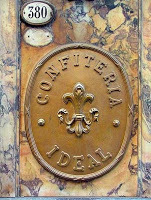 The French Fleur de Lys became the enigmatic emblem because at that time all of the expensive buildings in Buenos Aires were influenced by French architectural design, albeit La Belle Epoque of a few decades past. For that reason the premises seem much older than a scant century, and also because it is now derelict and decrepit. The gorgeous cage elevator hasn't worked in decades, and the iconic stained glass pastry quiosco glorieta empty but for the occasional tango shoe display.
The French Fleur de Lys became the enigmatic emblem because at that time all of the expensive buildings in Buenos Aires were influenced by French architectural design, albeit La Belle Epoque of a few decades past. For that reason the premises seem much older than a scant century, and also because it is now derelict and decrepit. The gorgeous cage elevator hasn't worked in decades, and the iconic stained glass pastry quiosco glorieta empty but for the occasional tango shoe display.
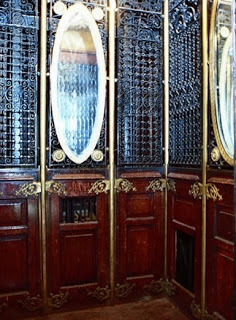 The gorgeous elevator that hasn't moved in decades
The gorgeous elevator that hasn't moved in decades
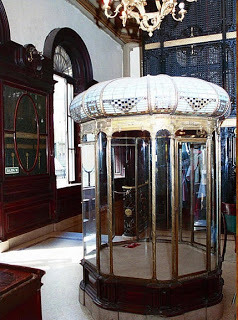 Emblematic empty display case
Emblematic empty display case
I will never forget walking up its marble staircase for the first time, smelling the mustiness, the cat piss, the burning incense lit to hide the odors of a building past its prime. I was a beginning tanguera in a culture that had seen very few tango tourists up to then. The milonga habitués looked upon our tour group from America as exotic creatures from another world, as I suppose we were. That's how we viewed the salon and the dancers of La Ideal.
All of this adds to its faded glamor.
Through the decades it was the place to meet your friends for afternoon tea, particularly after work. It became de riguer for the bourgoisie of Buenos Aires (especially the English) to meet there and have their private parties on Saturdays.
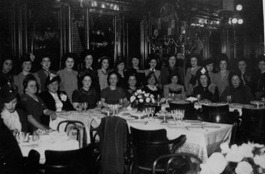
The upstairs ballroom was used for special occasions; the ground floor for tea, coffee, and the delicious pastries La Ideal was famous for, as well as live music. It's said that the miga sandwich was invented there as a copy of English finger sandwiches.
Between 1979 and 1981 it was converted into a café-concert with all types of live music, including a famous all-girl orchestra and The Five Latins. The salon has been visited over the years by many celebrities, such as Maurice Chevalier, Charles Aznavour, Mirta Legrand and Daniel Tinayre, Jorge Luis Borges, Ernesto Sábato, Yoko Ono, Sting, Charly García, Diego Maradona, Julio Bocca,Moria Casán, Willem Dafoe, Robert Duvall, María Félix, Dolores del Río, Vittorio Gassman ..
R
It also has been used as a location for all of the tango movies, so first-time visitors feel a déja-vu, of having dreamed this place. As indeed it is the stuff of dreams--many scenes in my memoir, The Church of Tango, take place in La Ideal.
Lots of rumors surround La Ideal, and no one seems to actually know who owns it--some say the government--but the truth is that it is owned by a private organization that receives no government help to maintain this historic structure. (It is managed by Jorge Vieites Rouco.) Unfortunately, it is falling apart before our eyes, even though it is now proclaimed an official Bar Notable. I wouldn't be surprised if one day a foreigner steps in to save it--in the manner of Versailles in France. Sometimes foreigners value a place's heritage more than the locals.
Several years ago the gigantic central chandelier below the skylight on the first floor, worthy of the Phantom of the Opera, crashed to the floor, and I presume never to be seen again.
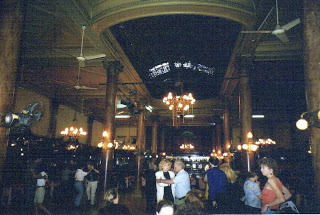 My photo from '97: see the huge chandelier? Now gone.
My photo from '97: see the huge chandelier? Now gone.
And on Oct 12, 2008--the ceiling falls:
Once upon a time there was the Gran Ciné Ideal (recently a porno theater) next door which insured that the confiteria was even more heavily used before and after film showings.
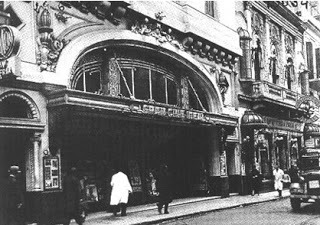 La Confiteria is at the right of the theater.
La Confiteria is at the right of the theater.
And a story which I find fascinating: originally the ceiling of the ground floor was open in an oval shape matching the skylight, and upstairs was a gallery around this opening for people to look down, and for light and the skylight to be seen from below. Years later the stone dance floor was laid down.
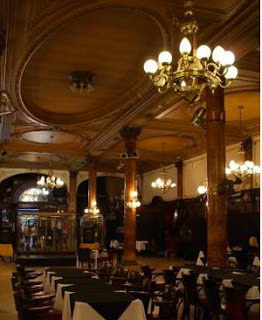 Here you can see the oval on the ceiling of the ground floor that used to be open
Here you can see the oval on the ceiling of the ground floor that used to be open
When I first visited La Ideal and took my first tango classes in Buenos Aires, there was only one milonga there, the Friday afternoon dance of Diego y Zoraida. Now there are more than twelve milongas every week in the same space, with classes from different teachers every day. Another recent change is that Suipacha has recently been made into a pedestrian street.
A visiting tourist might not actually know what tango is, but feels certain that the tango was born at La Ideal, although tango didn't arrive there until the middle of the 1990s, just shortly before I visited for the first time in 1997. I too thought I saw the ghosts of tangueros of dusty years past in the mirrors lining the walls. The building itself has a haunting presence and a life of its own. May it live forever.
The BBC Documentary
Read more: La Confiteria Ideal

However La Ideal spent almost all of its life since it was built in 1912 as a pastry shop and salon de te´, and it wasn't until the 1990s that tango dancing became its raison d'etre. The original owners were pastry chefs and entrepreneurs from Spain, who required that the building be constructed of expensive materials from all over Europe.
 The French Fleur de Lys became the enigmatic emblem because at that time all of the expensive buildings in Buenos Aires were influenced by French architectural design, albeit La Belle Epoque of a few decades past. For that reason the premises seem much older than a scant century, and also because it is now derelict and decrepit. The gorgeous cage elevator hasn't worked in decades, and the iconic stained glass pastry quiosco glorieta empty but for the occasional tango shoe display.
The French Fleur de Lys became the enigmatic emblem because at that time all of the expensive buildings in Buenos Aires were influenced by French architectural design, albeit La Belle Epoque of a few decades past. For that reason the premises seem much older than a scant century, and also because it is now derelict and decrepit. The gorgeous cage elevator hasn't worked in decades, and the iconic stained glass pastry quiosco glorieta empty but for the occasional tango shoe display. The gorgeous elevator that hasn't moved in decades
The gorgeous elevator that hasn't moved in decades Emblematic empty display case
Emblematic empty display caseI will never forget walking up its marble staircase for the first time, smelling the mustiness, the cat piss, the burning incense lit to hide the odors of a building past its prime. I was a beginning tanguera in a culture that had seen very few tango tourists up to then. The milonga habitués looked upon our tour group from America as exotic creatures from another world, as I suppose we were. That's how we viewed the salon and the dancers of La Ideal.
All of this adds to its faded glamor.
Through the decades it was the place to meet your friends for afternoon tea, particularly after work. It became de riguer for the bourgoisie of Buenos Aires (especially the English) to meet there and have their private parties on Saturdays.

The upstairs ballroom was used for special occasions; the ground floor for tea, coffee, and the delicious pastries La Ideal was famous for, as well as live music. It's said that the miga sandwich was invented there as a copy of English finger sandwiches.
Between 1979 and 1981 it was converted into a café-concert with all types of live music, including a famous all-girl orchestra and The Five Latins. The salon has been visited over the years by many celebrities, such as Maurice Chevalier, Charles Aznavour, Mirta Legrand and Daniel Tinayre, Jorge Luis Borges, Ernesto Sábato, Yoko Ono, Sting, Charly García, Diego Maradona, Julio Bocca,Moria Casán, Willem Dafoe, Robert Duvall, María Félix, Dolores del Río, Vittorio Gassman ..
R
It also has been used as a location for all of the tango movies, so first-time visitors feel a déja-vu, of having dreamed this place. As indeed it is the stuff of dreams--many scenes in my memoir, The Church of Tango, take place in La Ideal.
Lots of rumors surround La Ideal, and no one seems to actually know who owns it--some say the government--but the truth is that it is owned by a private organization that receives no government help to maintain this historic structure. (It is managed by Jorge Vieites Rouco.) Unfortunately, it is falling apart before our eyes, even though it is now proclaimed an official Bar Notable. I wouldn't be surprised if one day a foreigner steps in to save it--in the manner of Versailles in France. Sometimes foreigners value a place's heritage more than the locals.
Several years ago the gigantic central chandelier below the skylight on the first floor, worthy of the Phantom of the Opera, crashed to the floor, and I presume never to be seen again.
 My photo from '97: see the huge chandelier? Now gone.
My photo from '97: see the huge chandelier? Now gone.And on Oct 12, 2008--the ceiling falls:
Once upon a time there was the Gran Ciné Ideal (recently a porno theater) next door which insured that the confiteria was even more heavily used before and after film showings.
 La Confiteria is at the right of the theater.
La Confiteria is at the right of the theater.And a story which I find fascinating: originally the ceiling of the ground floor was open in an oval shape matching the skylight, and upstairs was a gallery around this opening for people to look down, and for light and the skylight to be seen from below. Years later the stone dance floor was laid down.
 Here you can see the oval on the ceiling of the ground floor that used to be open
Here you can see the oval on the ceiling of the ground floor that used to be openWhen I first visited La Ideal and took my first tango classes in Buenos Aires, there was only one milonga there, the Friday afternoon dance of Diego y Zoraida. Now there are more than twelve milongas every week in the same space, with classes from different teachers every day. Another recent change is that Suipacha has recently been made into a pedestrian street.
A visiting tourist might not actually know what tango is, but feels certain that the tango was born at La Ideal, although tango didn't arrive there until the middle of the 1990s, just shortly before I visited for the first time in 1997. I too thought I saw the ghosts of tangueros of dusty years past in the mirrors lining the walls. The building itself has a haunting presence and a life of its own. May it live forever.
The BBC Documentary
Read more: La Confiteria Ideal
Published on December 06, 2011 09:29
November 21, 2011
Annual Thanksgiving Post
Just like Art Buchwald used to do with his Thanksgiving column explaining the custom to the French, here is a republishing of my annual Thanksgiving post. Happy Thanksgiving to everyone, even if this coming Thursday isn't your traditional day. We all have much to be grateful for.
Each autumn when the harvest is brought in, the people of the world throw a party. Here in Argentina the grape harvest is celebrated in March in Mendoza. But at any time during the year, somewhere in the world people are giving thanks for their blessings.
The biggest holiday in the U.S. is celebrated on the fourth Thursday of November, and is also a harvest festival. Bigger than Christmas or the 4th of July, it is Thanksgiving Day. No matter the culture, race, or religion, on this day the salad bowl of American people are united by one tradition: a family feast of traditional foods (with ethnic specialities often added), and then football on TV.
Did you know that eight nations of the world have official Thanksgiving Days? -- Argentina, Brazil, Canada, Japan, Korea, Liberia, Switzerland and the United States. (But try as I might, I could find no information on Thanksgiving in Argentina.)
The ancient tradition of declaring a special day or period for giving thanks goes back to the time when our ancestors hoped that an ostentatious display of gratitude would placate their capricious gods - thus ensuring continued bounty. But these days of thanksgiving were also occasions for celebrating the year's plenty with feasts and joyful gatherings.
Proclaiming days of Thanksgiving for various reasons - success in war, a bounteous harvest, the recovery of a king from illness - was part of European tradition for centuries.
Modern North American Thanksgiving lore is associated with the Pilgrims. In 1621, a year after arriving in the new world on the Mayflower, and following a severe winter in which many of their numbers had succumbed to disease, the colonists celebrated their first successful harvest by organizing a thanksgiving feast to which they invited the neighboring Native Indians. On the menu for that first American Thanksgiving were almost certainly some foods that are staples of the holiday today - turkey and pumpkin - along with other wild fowl, venison, oysters, clams, fish, corn cakes, and wild fruit and nuts.
But enough about history! What's for dinner?

On most North American tables, a turkey still holds pride of place for the annual Thanksgiving feast. In the US alone, over 40 million turkeys are consumed on this holiday weekend each year!
In November 1997 the United Nations General Assembly unanimously declared the year 2000 as the official International Year of Thanksgiving.

That same year, an English writer and director, Gurinder Chadha, came out with the quintessential American Thanksgiving movie, called, WHAT'S COOKIN? In it, four families in Los Angeles, my hometown, celebrate Thanksgiving Day. The families are Mexican, Vietnamese, Jewish, and black, and show the dysfunctions and problems that all families have in common. On Thanksgiving Day, their commonality is also thankfulness.
We all have something to be grateful for, especially we expats, even though it's hard to be far from home and family on this most American of holidays.
Springtime in Buenos Aires is not turkey time, and last year we had a delicious Argentine barbecue on our terrace, but still, on Thanksgiving Day and every day, I am thankful for you, dear readers!
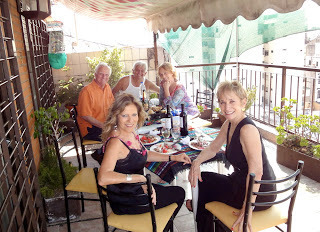
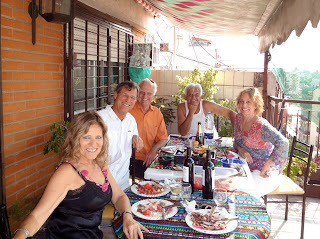
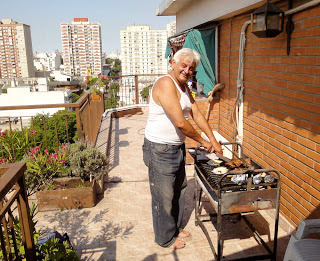

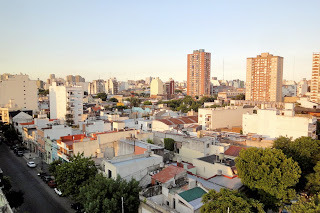
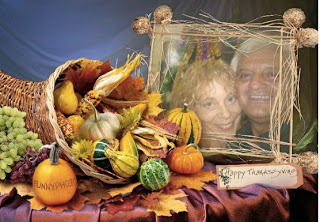

Each autumn when the harvest is brought in, the people of the world throw a party. Here in Argentina the grape harvest is celebrated in March in Mendoza. But at any time during the year, somewhere in the world people are giving thanks for their blessings.
The biggest holiday in the U.S. is celebrated on the fourth Thursday of November, and is also a harvest festival. Bigger than Christmas or the 4th of July, it is Thanksgiving Day. No matter the culture, race, or religion, on this day the salad bowl of American people are united by one tradition: a family feast of traditional foods (with ethnic specialities often added), and then football on TV.
Did you know that eight nations of the world have official Thanksgiving Days? -- Argentina, Brazil, Canada, Japan, Korea, Liberia, Switzerland and the United States. (But try as I might, I could find no information on Thanksgiving in Argentina.)
The ancient tradition of declaring a special day or period for giving thanks goes back to the time when our ancestors hoped that an ostentatious display of gratitude would placate their capricious gods - thus ensuring continued bounty. But these days of thanksgiving were also occasions for celebrating the year's plenty with feasts and joyful gatherings.
Proclaiming days of Thanksgiving for various reasons - success in war, a bounteous harvest, the recovery of a king from illness - was part of European tradition for centuries.
Modern North American Thanksgiving lore is associated with the Pilgrims. In 1621, a year after arriving in the new world on the Mayflower, and following a severe winter in which many of their numbers had succumbed to disease, the colonists celebrated their first successful harvest by organizing a thanksgiving feast to which they invited the neighboring Native Indians. On the menu for that first American Thanksgiving were almost certainly some foods that are staples of the holiday today - turkey and pumpkin - along with other wild fowl, venison, oysters, clams, fish, corn cakes, and wild fruit and nuts.
But enough about history! What's for dinner?

On most North American tables, a turkey still holds pride of place for the annual Thanksgiving feast. In the US alone, over 40 million turkeys are consumed on this holiday weekend each year!
In November 1997 the United Nations General Assembly unanimously declared the year 2000 as the official International Year of Thanksgiving.

That same year, an English writer and director, Gurinder Chadha, came out with the quintessential American Thanksgiving movie, called, WHAT'S COOKIN? In it, four families in Los Angeles, my hometown, celebrate Thanksgiving Day. The families are Mexican, Vietnamese, Jewish, and black, and show the dysfunctions and problems that all families have in common. On Thanksgiving Day, their commonality is also thankfulness.
We all have something to be grateful for, especially we expats, even though it's hard to be far from home and family on this most American of holidays.
Springtime in Buenos Aires is not turkey time, and last year we had a delicious Argentine barbecue on our terrace, but still, on Thanksgiving Day and every day, I am thankful for you, dear readers!






Published on November 21, 2011 07:11
November 19, 2011
Thanks for the Memoirs!
Just as my own memoir,
The Church of Tango
, is readying itself for publication, there is yet another woman's tango memoir soon to be published in the UK. I guess that proves there is an audience out there. Where are the tango memoirs written by men? There are a couple of excellent books by men,
Long After Midnight at the Nino Bien
, kind of a non-fiction novelized travelogue by yanqui Brian Winter, and
Here At the End of the World We Learn to Dance,
a well-written novel by kiwi Lloyd Jones, a prize-winning author.
Now there is Twelve Minutes of Love by Kapka Kassabova, a Bulgarian who currently lives in Scotland, which is beingpublishedthis month by Portobello Books. Here is the artistic trailer for the book, featuring oil paintings by animation artist Em Cooper, music by Piazzolla, and stage tango moves.
Do I have a dirty mind or are there ink blot references to a woman's anatomy?
I understand why there are so many tango blogs and memoirs, as people are trying to explain to themselves and others the profundity and emotional content of this dance that is inexplicable in words. Men write tango blogs, but as yet no tango memoir. I wish I were a psychologist so I could speculate as to why. And why women feel compelled to share their emotional tango journeys with others.
You can listen to a BBC interview with Kapka, as well as our own Sally Blake, author of Happy Tango: Sallycat's Guide to Dancing in Buenos Aires.
And now I'd better get to work on my video trailer for The Church of Tango ! Any ideas for me out there?

Now there is Twelve Minutes of Love by Kapka Kassabova, a Bulgarian who currently lives in Scotland, which is beingpublishedthis month by Portobello Books. Here is the artistic trailer for the book, featuring oil paintings by animation artist Em Cooper, music by Piazzolla, and stage tango moves.
Do I have a dirty mind or are there ink blot references to a woman's anatomy?
I understand why there are so many tango blogs and memoirs, as people are trying to explain to themselves and others the profundity and emotional content of this dance that is inexplicable in words. Men write tango blogs, but as yet no tango memoir. I wish I were a psychologist so I could speculate as to why. And why women feel compelled to share their emotional tango journeys with others.
You can listen to a BBC interview with Kapka, as well as our own Sally Blake, author of Happy Tango: Sallycat's Guide to Dancing in Buenos Aires.
And now I'd better get to work on my video trailer for The Church of Tango ! Any ideas for me out there?
Published on November 19, 2011 05:56
November 15, 2011
B.A. Tango #209 Download Here
The latest quarterly edition of the complete guide to tango in Buenos Aires. To better preserve the graphic definitions, the digital magazine is in three parts:
aBAT 209 Digital 1
aBAT 209 Digital 2
aBAT 209 Digital 3
aBAT 209 Digital 1
aBAT 209 Digital 2
aBAT 209 Digital 3
Published on November 15, 2011 14:42
October 26, 2011
Friends Forever or Acquaintances for Now?
 In the States, "everyone" is our "friend," even if we just met them. It's our culture and our language. We want to be friendly. We smile a lot and try to act friendly.
In the States, "everyone" is our "friend," even if we just met them. It's our culture and our language. We want to be friendly. We smile a lot and try to act friendly.We talk about Man's Best Friend, we belong to the Friends of the Library, we are Best Friends Forever with someone for a week.
I'm a person who has few friends, but the ones I have are "cherce!" My current friends in Buenos Aires are not at all the ones I thought I had when I moved here permanently. I had met some local people on several vacation dancing trips since 1997, other foreign dancers like me, and of course, the milongueros. I enjoyed the company of these folks; I didn't feel so alone thinking I had friends here.
When I became a "local" myself in 2003 and people saw me every day, I lost glamour. I was no longer the exotic foreigner who came and went, bearing gifts. The milongueros became noticeably uncomfortable that I was always here, watching and comparing notes with others. They saw me like the local I now was. Many milongueros enjoy the fact that tourists hit and run, leaving them free to start a fresh seduction with someone new and innocent. The game can be more important to them than the conquest.
While I continued to enjoy "friendship" with local ladies, I realized that I felt used. People I hardly knew asked me to bring them all sorts of things with no offers of reimbursement. I had parties and invited these "old friends" as well as new ones I was making. But they didn't participate or reciprocate. One local did invite me to a party but then charged me for the food Ruben and I ate, despite our bringing wine and a gift. Others tried to profit off of my foreign friends, trying to sell them shoes, tango clothes, jewelry, tours, places to stay.
When I couldn't afford anymore to invite locals out to restaurant dinners as I used to, our relations changed. There is a common attitude of "foreigner = money" and there are certain expectations.
Many tango tourists do as I used to do and enjoy treating local dancers. Ruben and I love treating folks to an empanada lunch or an asado at our apartment. The error is to consider everyone our "friends." We throw that word around a lot in English, rarely using "acquaintance" as Ruben does to describe our relationships, but in Spanish, people don't often talk about "amigos." After all, real strong and enduring friendships are infrequent and not that easy to make. What do they say, a friend is someone we can call at 3 a.m. to take us to the emergency room? We shouldn't fool ourselves that everyone we know would do that for us.
Do we believe that all those friendly folks at the milongas are our friends? Do we even know much about them? We know how they dance and if they smell good and perhaps in what part of town they live in, but usually that is about all. Because we are not there to make life-long friends; we are there to have dance and fun. Sometimes knowing too much about a dance partner ruins the experience. It's wonderful to have acquaintances, "conocidos," too.

In searching for an illustration for this post, the "friends" images on Google were either of animals, children, or the "Friends" TV series. "Acquaintance" images were mostly cartoons, and posters for the Bette Davis movie, "Old Acquaintance."

In Spanish, the primary images for "amigo" are cars and electric wheel chairs (??!) For "conocido" it's pictures of men alone, including Jesus and Che Guevara. For "conocida," the female acquaintance, it's the Virgin, flowers, and fairies. Go figure.
My favorite theme of "Sex and the City" was the bond between the four women. The writing portrayed the quality of friendship as more important and enduring than a date with a man, as real life female relationships have tended to do the opposite: I'll spend the evening with you as long as a man doesn't call me for a date. Some of the moments with the TV women expressing love and caring for each other in difficult circumstances often brought me to tears. I didn't envy their Jimmy Choos, their apartments, jobs, or boyfriends--I wanted a circle of friends like that. But it wasn't reality. And there are certainly few real friendships in Tinsel Town. But the ones I have are "cherce!"
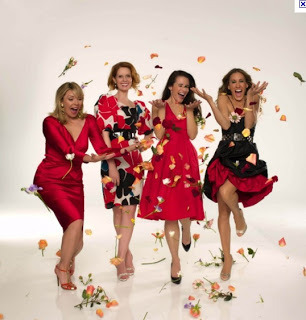
Published on October 26, 2011 17:57
October 23, 2011
Intimo Maximiliano Guerra
With the retirement of Julio Bocca, Maxi Guerra has become the #1 male superstar of Argentine dance. He's getting a little older now (over 44) and is broadening his horizons by being a judge on the TV show, Talento Argentino, and moving out of the strictly classical dance he is famous for.
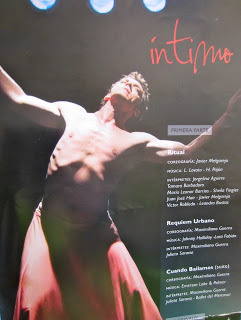
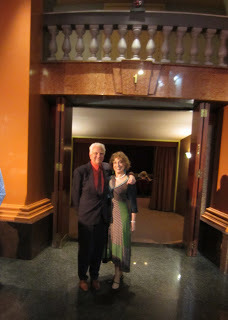
Last week I attended a gala benefit for the hospital volunteer society, Damas Rosadas, in the gorgeous old Teatro Avenida on Avenida de Mayo, starring Maxi and the Ballet del Mercosur. He has donated much time and energy over the years to various charities and this program was no exception.
In this "Intimo" program of four short pieces, Guerra wanted to show the various influences on his life and career over time, an homage to his roots and culture.
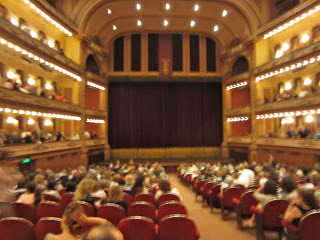
The show began with "Ritual," a ballet to folklore music like the Zamba and Chacarera and also African folklore by way of Cuba. Reminded me somewhat of the Rite of Spring. Then Maxi and his fantastic ballerina, Julieta Saravia, danced an impressive pas de deux, "Requiem Urbano" choreographed by him to French music of the 60s. The third piece, "Cuando Bailamos," also choreographed by Guerra, was set to Emerson Lake & Palmer, and had ballerinas on point dancing disco moves. I thoroughly enjoyed this first half of the show despite the over-reliance on the smoke machine, which made it difficult to see everything clearly despite our excellent seats. I can only imagine what the dancers felt breathing it in.
After intermission, a tango piece by Mora Godoy closed the show. Unfortunately the choreography was uninspired, repetitive, gancho-heavy, and boring. And a waste of Maxi's talents, proving once again that a great classical dancer is not necessarily able to dance tango as it should be danced.
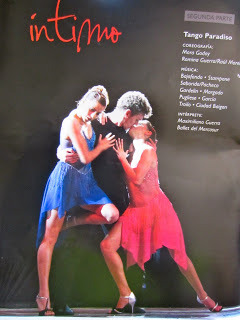 I applaud this generous artist of spectacular charisma and talent for tirelessly giving back from his kind heart. I enjoyed my night out with a good friend for a good cause, and we finished the warm spring evening on the sidewalk in front of Los 36 Billiards with huge drinks of vodka while a couple performed tango inside to live flamenco music (!)
I applaud this generous artist of spectacular charisma and talent for tirelessly giving back from his kind heart. I enjoyed my night out with a good friend for a good cause, and we finished the warm spring evening on the sidewalk in front of Los 36 Billiards with huge drinks of vodka while a couple performed tango inside to live flamenco music (!)


Last week I attended a gala benefit for the hospital volunteer society, Damas Rosadas, in the gorgeous old Teatro Avenida on Avenida de Mayo, starring Maxi and the Ballet del Mercosur. He has donated much time and energy over the years to various charities and this program was no exception.
In this "Intimo" program of four short pieces, Guerra wanted to show the various influences on his life and career over time, an homage to his roots and culture.

The show began with "Ritual," a ballet to folklore music like the Zamba and Chacarera and also African folklore by way of Cuba. Reminded me somewhat of the Rite of Spring. Then Maxi and his fantastic ballerina, Julieta Saravia, danced an impressive pas de deux, "Requiem Urbano" choreographed by him to French music of the 60s. The third piece, "Cuando Bailamos," also choreographed by Guerra, was set to Emerson Lake & Palmer, and had ballerinas on point dancing disco moves. I thoroughly enjoyed this first half of the show despite the over-reliance on the smoke machine, which made it difficult to see everything clearly despite our excellent seats. I can only imagine what the dancers felt breathing it in.
After intermission, a tango piece by Mora Godoy closed the show. Unfortunately the choreography was uninspired, repetitive, gancho-heavy, and boring. And a waste of Maxi's talents, proving once again that a great classical dancer is not necessarily able to dance tango as it should be danced.
 I applaud this generous artist of spectacular charisma and talent for tirelessly giving back from his kind heart. I enjoyed my night out with a good friend for a good cause, and we finished the warm spring evening on the sidewalk in front of Los 36 Billiards with huge drinks of vodka while a couple performed tango inside to live flamenco music (!)
I applaud this generous artist of spectacular charisma and talent for tirelessly giving back from his kind heart. I enjoyed my night out with a good friend for a good cause, and we finished the warm spring evening on the sidewalk in front of Los 36 Billiards with huge drinks of vodka while a couple performed tango inside to live flamenco music (!)
Published on October 23, 2011 08:24
October 10, 2011
Champagne, Blanco, Rosado, Tinto--en esta orden!
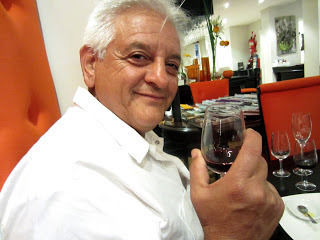 Happy Camper!
Happy Camper!Ruben and I were invited to share in the Anuva Wine Tastings at the Rendez-Vous Hotel in where else but the expat gringolandia of Palermo last week. I've had the affiliate link at the top right of my blog for quite a while, but didn't have first hand experience. Now I can wholeheartedly recommend a couple of hours in the company of Dan Karlin, the founder, and Sarah of Anuva Wines who teach and share their knowledge of hard-to-find Argentine wines, as well as sharing generous pourings of the wines in question.
We tasted five excellent wines from the lower priced portion of their wine list which all sell for around $20-25 usd a bottle. You can purchase the wines on the spot or have them shipped. There was little pressure to buy.
The favorite of the evening was the Mairena Bonarda 2006, a delicious red at $20. The others were Hom sparkling, Carinae Torrontes, San Gimignano Syrah, Caluna Blend.
The experience is definitely for tourists, especially those from the U.S., and recommended at the beginning of their Argentina visit so they can know a little more before imbibing throughout their journey. The tastings are primarily given in English, but a Spanish option is available by request. We were lucky that ours was bilingual because of Ruben and a Brazilian couple. The other guests didn't speak English, so Dan stepped up to the plate and did double duty.
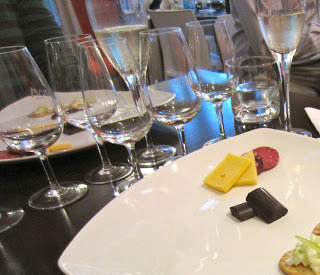 I had read on the website that tapas would be served that go with each of the wines, but as you can see from my photo the food is not Spanish tapas of hot and cold dishes, but just small tasty bites.
I had read on the website that tapas would be served that go with each of the wines, but as you can see from my photo the food is not Spanish tapas of hot and cold dishes, but just small tasty bites.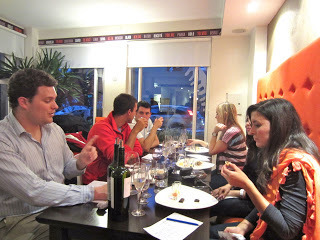 The tastings are held in the small lobby of the hotel, and it was a cozy and comfortable ambiance. I think it would be great fun to organize a tasting for your own group, or even as a birthday party.
The tastings are held in the small lobby of the hotel, and it was a cozy and comfortable ambiance. I think it would be great fun to organize a tasting for your own group, or even as a birthday party. 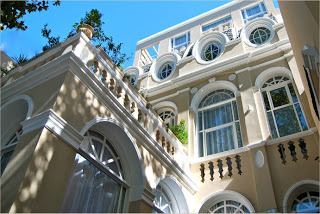 Hotel Rendez-Vous
Hotel Rendez-VousThe two-hour tasting costs $46 usd/person, which is too high for the locals, but as part of a vacation "splurge" for those who want to understand the Argentine wine culture, which is little known outside the country, it's probably worth it. These are not wines you can pick up in Coto or your local Chinese supermarket, but boutique wines from small wineries with limited distribution.
If you decide to make a reservation to attend a tasting, I would so appreciate it if you use the link here Anuva Wine Tastings or the graphic link up top. Thanks--tangocherie gets credit that way.
Published on October 10, 2011 05:49
October 5, 2011
"Dark Tangos" Novel as a Free Download
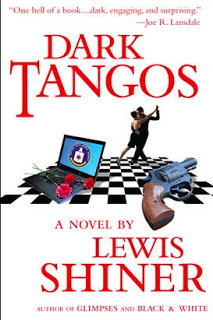 The starred review from BOOKLIST said, "Delivers its grim story line with artistic mastery....Short and precise, the novel uses the elegance of tango to radiate sensuality throughout. This is an absorbing and surprisingly action-packed tale based in the ugly truths of Argentina's history.'"
The starred review from BOOKLIST said, "Delivers its grim story line with artistic mastery....Short and precise, the novel uses the elegance of tango to radiate sensuality throughout. This is an absorbing and surprisingly action-packed tale based in the ugly truths of Argentina's history.'"I'm reading the novel now and think it's excellent, especially the description of the tango and the milonga scenes.
You can download the free PDF file from the BoingBoing website--just click the book cover.
It's kind of discouraging because I'm getting my memoir, The Church of Tango, ready to publish. And Mr. Shiner is giving his ebook away for free. You can still purchase a hardback copy on Amazon for $23.10.
Published on October 05, 2011 06:27



